FAQs About Soft/Shell Rot, Conditions In Turtles
11
Related Articles: Shell Rot in Turtles, Treating Common Illnesses of
the Red Ear Slider (& other Emydid Turtles) by Darrel
Barton, The
Care and Keeping of the Red Eared Slider, Trachemys scripta elegans by
Darrel Barton, Red Ear Sliders, Turtles, Amphibians, Red
Eared Slider Care,
Related FAQs: Shell
Rot 1, Shell Rot 2,
Shell Rot 3, Shell Rot, Conditions 4, Shell Conditions 5, Shell Conditions 6, Shell Conditions 7, Shell Conditions 8, Shell Conditions 9, Shell Conditions 10, Shell Conditions 12, Shell Conditions 13,
Shell
Conditions 14, Shell Conditions
15, Shell Conditions 16,
Shell Conditions 17,
& Turtles, Turtles
2, Turtle Identification,
Turtle Behavior, Turtle Compatibility, Turtle Selection, Turtle Systems, Turtle Feeding, Turtle Disease, Turtle Disease 2, Turtle Disease 3, Turtle Reproduction, Amphibians, Other
Reptiles,
|
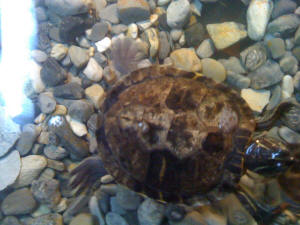
|
|
Re: Female Red Ear Slider Turtle with
white spots
was: Female Red Ear Slider Turtle, lack of data
1/19/11
<Darrel here in for Bob>
Thank you, yes I have read this article and I am doing the
treatment tonight for the "shell rot" just in case.
<A wise choice>
Will this work for hard water build up as well or will that just
go away with mild soap and a tooth brush? I am so afraid because
I can't afford a rep vet, so I am doing anything I can to
take care of her my self, she
seems really stressed over me doing the treatment but she is
drying out now and then I will be putting the ointment on,
letting it dry a bit "10 min.s" and then placing her
back in her tank.
<It's stressful for her, yes. But then - she doesn't
have to go to work or school, doesn't have money worries,
etc. so I'm more worried about your stress than hers.>
<The treatment for hard water and/or mineral deposits is a
scrub with a little bit of vinegar, which isn't bad for shell
fungus either, so why don't you alternate the
treatments?>
Also will this treatment effect the water? Will I need to change
it completely after the week is done?
<I wouldn't worry about it, the slight traces in the water
don't really affect much - and the regular partial-water
changes you make will take care of it>
Sorry I also have one more question. If the "condition"
clears up before the week do I want to continue or stop once its
clear?
<Once it appears clear, go 3 or 4 more days just to get the
stuff that you can't see>
<Also, see that Izzy gets as much natural sunshine as your
time and situation allows.>
Thank you so very much for your help in this, as I really care
for animals, We are just strapped for cash right now...like have
none, spent the last 12 dollars on the Iodine solution for
her...so I really hope it works!!
Ugh...so stressful...sorry for so many questions, I really
appreciate you time!! Thank you so so much!!
Savanah For Izzy the RES Turtle
<Savanah - remember -- it took a long time for whatever it is
to build up slowly, so it will take a bit of time for it to clear
up as well. Take your time, do your best and don't
fret.>
Re: Female Red Ear Slider Turtle with
white spots 1/24/11
Darrel,
Thank you so much!
<Yer welcome!>
I am still doing the treatments. You message got lost in my
stuffed mailbox...ugh...
<I hate when that happens>
but I will try the vinegar tomorrow but I am sure some spots are
shell rot...seems a little flaky on some spots, would this be
consistent with shell rot?
<Still hard to say. Sorry to sound like a Magic-8-Ball here
'¦ but the description fits so many possibilities. The
next thing here is to get Izzy warm and dry. Follow the
"isolation" treatment in this article:
http://www.wetwebmedia.com/FWSubWebIndex/treating%20RES%20Dis%20DarrelB.htm
Whatever is ailing her has the advantage in the warm, wet world
she normally inhabits.>
Since we live in WA there is practically no natural sunlight but
as soon as it shows she will be out in it.
<Does he have a UV-B bulb in her tank? She should>
I got her a water conditioner that has calcium and a cuttle bone,
hoping it helps as well. Can diet create shell rot?
<Diet can't exactly CREATE shell rot, but poor diet leads
to a weakened animal and when the animal's natural defenses
are weakened ANY disease can more easily take root.>
<The water conditioner and the cuttle bone are both wastes of
your time and money, in my opinion. Turtles get their calcium
through their diet, they don't absorb it through their skin,
so in order to build up enough calcium in the water for her to
drink enough to help anything is impossible. It wouldn't be
water anymore it would be plaster.>
<The best money spent would be on a good UV-B light and a warm
basking area.>
Read here on treatment
http://www.wetwebmedia.com/FWSubWebIndex/treating%20RES%20Dis%20DarrelB.htm
And here on basic requirements
http://www.wetwebmedia.com/FWSubWebIndex/RESCareBarton.htm>
Thanks again
Savanah
|
|
Red Eared/Yellow Bellied Slider Help!!
10/29/10
Hello, My name is Alex,
<Hiya - I'm Darrel>
I have two sliders, one red eared (Jude) and one yellow bellied
(Lucy) in a 75 gallon aquarium with a canister filter, heat lamp,
and UVA/UVB lamp. They each have different problems right now,
but maybe the cause is the same? I'll start with Jude:
<OK>
Jude is recovering from a fungus infection on his
shell. It used to be a lot worse, but I dry-docked him
without any lights or heat (I know this was wrong, and have
remedied it as of today), and applied Nolvasan to his shell just
about every day with a toothbrush. Some days, I would mix
Nolvasan with water and let him bathe in it for 30 minutes or so
(keeping the water low enough for his head to stick out). Now I
have him back in the tank (75 gal with a canister filter). You
can't really tell when he's out of the water, but in the
water, his shell is still shiny in the places that the fungus
was. Also, his shell feels slippery compared to Lucy's.
Should I continue treatment/dry-docking? How will I know when
he's better?
<Yes, you should continue. Also a change of medications is in
order. A disinfectant is fine, but what you want for Jude
specifically is an anti-fungal agent. Tolnaftate, which is a
common antifungal in athlete's foot creams is great. Lotrimin
or any generic version is fine also. Apply once a day, right
after his bath and leave him DRY. Dry and warm. I'll enclose
a treatment article that explains the dry-docking and the daily
bathing in a bit more detail.>
The course of treatment for a fungus is a minimum of 4 weeks,
preferably 6 weeks, with heat and UV-B exposure>
<
http://www.wetwebmedia.com/FWSubWebIndex/treating%20RES%20Dis%20DarrelB.htm>
<.>
Lucy on the other hand, has an injury on the top of her
head/neck:
<Ouch>
It was really challenging to get a good picture of this, but
hopefully those two will be sufficient. It appeared out of
nowhere one day (and I check them almost daily; some days
I'll forget, but I'm usually really good about it), which
leads me to believe that it's a cut caused by her shell?
Maybe she dove down too quick, hit her head on a rock, and the
front/top of her shell caused the cut? Some days, it appears to
have some white build up around the edges (fungus?) and other
days, like today, it's mostly red.
<Probably a bit of both. Injuries lead to opportunistic
fungi>
I've also been dry-docking her on and off for the past 10-12
days.
<Off and on doesn't help. Read the treatment article and
put in dry-dock fro 4 6 weeks, just like Jude>
I also treat the wound with Nolvasan. After she eats (in water of
course), I wait for her to stretch her head out, and apply a few
drops directly to the wound from the bottle. I noticed today
while taking the pictures that her eyes were swollen shut (she
could only open them slightly to see her food), but 15 minutes
later as I'm typing this, her eyes are wide open.
<That's bad news. The #1 cause is a vitamin deficiency
from food. Not enough Vitamin-A. The treatment article addresses
that, as well.>
Both turtles are eating normally. I feed them ZooMed Natural
Aquatic Turtle Food every 2-3 days, and about every second or
third feeding, I'll give them ZooMed Turtle Treats (whole
krill). Back when Jude was being dry-docked, he wouldn't eat
unless I offered the pellets and the krill. I guess he was just
stressed out from dry-docking?
<Stressed and a bit sick. They both need an enhanced /
augmented diet. Either soak their pellets Cod liver oil or feed a
bit of raw beef liver (or both) every day for a few weeks. It may
take some time for them to come around to eating, but when they
get hungry enough, they WILL eat it.>
Also, with the dry-docking: up until today, I've just had
them sitting in a plastic tub with no lights. Now I have a UVA
lamp and a 75 watt light bulb hanging over the tank.
<UV-A? They need UV-B specifically.>
Lucy's still in dry-dock, but I've been keeping Jude in
the tank for a couple of weeks now. How should I proceed with
both animals from here?
<Too soon for Jude. Dry-dock them both, as described in the
article, heat, UV-B, High Vitamin A foods, topical antifungal.
Daily baths (no more than 10 minutes) for drinking, pooping and
eating '¦ and natural sunlight if you can -- take them
outside and let them bask in the sun for 15-20 minutes each day
*IF* (and only IF) you can watch them every second>
One final question: I'm almost positive that Jude's a
male and Lucy's a female (lucky guess when I bought them, I
suppose). Will they be able to mate, even though they're
different species?
<Absolutely. They can easily produce baby Slider belly
turtles>
When they're both in the tank, Jude follows Lucy around
trying to do his mating dance, but she never responds/seems
annoyed. I know it takes longer for the females to reach sexual
maturity, but can I expect some breeding at some point in the
future?
<It's not exactly longer, Alex. It's size. Reptiles
get sexually mature with size. Male turtles are naturally
smaller, so Lucy has maybe 3 or 4 more years of just being
annoyed that Jude is interested in something she
isn't.>
Thanks so much for all your help; I'm eagerly awaiting your
answer. :)
Alex
PS: You guys have an AWESOME site that answered a lot of my
questions (i.e. using lights in the dry-dock), but I just wanted
to shoot this off to be ultra-sure about their conditions.
<We really ARE incredible, aren't we????>
Thanks again!
<Yer welcome?>
|
|
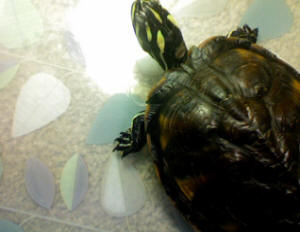 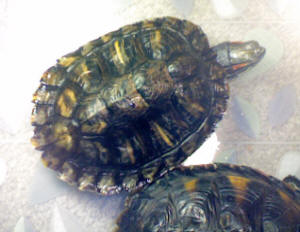
|
|
Turtle help!
Res help! - 10/10/10
Hello, My name is Vinetta.
<Hiya - Darrel here>
I was hoping you could help me out with a few questions.
<You have questions? I have '¦ um .. er .. ah ..
something>
Three days ago the maintenance man at my apartment complex came
to me, ( I am an animal lover and everyone comes to me when they
find or want to unload unwanted pets),
<We should form a posse and track down people like that and
have their names added to nut/kook/cult mailing lists>
-- because someone moved out 3 weeks ago and left a Red Eared
Slider in a 10 gallon tank with about 2 inches of water which was
black and nasty. I must add that this turtle is roughly about 5
inches wide,( about the size of a bread plate), maybe a little
more.
<Likely to be a "her" at that size>
I took him and cleaned him off, which brings me to my 1st issue,
thin scales came off when I rubbed his shell with my fingers to
remove the slime that coated him. I've read that this does in
fact happen, but in a few spots his shell is a whitish color with
a few tiny spots of red. Is this something I can correct on my
own?
<yes. The thin scales (called scutes) normally shed with age
& growth - the white spots sound fungal - the red spots
indicating either very advanced fungal or bacterial>
And if so, how?
<It's not hard, either. Here is a link:
http://www.wetwebmedia.com/FWSubWebIndex/treating%20RES%20Dis%20DarrelB.htm
Treat as if he had a fungal infection (he probably does)>
<The main thing we want now is warm and DRY, DRY, DRY!!
Everything he's fighting is more virulent while he's warm
& moist>
I have for the time being put him in the largest tank I have,
which is about 20 gallons and long. I plan on in the very near
future getting something larger, but for now this is what I was
able to do.. I have filled it a little more than half way full of
water, placed a large rock for basking, a cuttle bone, pebbles at
the bottom and a clamp lamp with a 65 watt spotlight to bask
with. Right now the water reads about 75 degrees with a small 2
to 5 gallon tank submersible heater. ( I read that room
temperature is fine, but my house runs a little on the cool side
so I figured a small heater might be Ok..) The basking temp is
about 82 degrees.
<Cool side is fine as long as you're not into the mid
60's. I'd rather her have water on the cool side that to
have a heater in the tank. The AIR on the other hand *IS* a
little cool. When she's ready to go back in '¦ try
to get the basking area to between 88-90 (just bring the lamp a
1/2 inch or so closer>
I also have a filter running. I'm going to buy a turtle
conditioner thingy that you put in the tank later today.
<No need. Those things are of little to no value>
I am going to use the 10 gallon tank to feed him in. I've
bought some commercial turtle pellets, and some romaine lettuce.
I do not have a UV light yet, but I do have him sitting close to
a window. Is this enough to help him start to recover?
<UV light does not travel well through glass -- or even
windows screen, believe it or not. Is there a chance that you
could take him outside for a walk for even 10 minutes of sunlight
per day until you get the UV? Even that little bit will
help>
Also I've noticed when he swims he sometimes kind of tilts to
the side a bit. Not all the time but a I've noticed it a few
times. Is this normal?
<Sometimes, yes. Gas bubbles inside their gut can make them
float unevenly. It COULD also be the sign of a serious infection
'¦ but lets' not go looking for trouble here -
just assume it's no big deal>
I've had all kinds of reptiles as pets, but this is the first
turtle. So I'm pretty clueless. I am trying to do the best I
can with what I can afford at the moment, seeing as how I
hadn't PLANNED on taking in a turtle...loll.
<Welcome to a very large club. Orphanages, Irish Families and
Pet keepers see to live by the motto "there's always
room for one more!">
Also he does not seem very friendly, as is understandable, but if
given time and the right treatment do you think he will
eventually come around?
<They often do. As she equates you with her food supply, she
may come around>
I am enclosing a picture of him doing the tilting thing, also in
the picture you can see the white spot. (The water is still
slightly cloudy as I have just cleaned the tank and installed the
filter). Also included is another picture of the whole set up to
show you what I have done, and to help assist you in any advice
on how to improve it. Any help or advice you can give me would be
much appreciated.
Thank You for your time!
~Vinetta~
<The pictures show a couple things. First, any time she wants,
she can climb right out of than tank and take a bad tumble.
She'll likely survive that, but then will go for a walk
'¦ and if you're new to turtles you should know
that they can climb in ways beyond imagination, can move at
barely sub-light speed when you take your eyes off of them for
just a second and they choose to get into places that you
didn't even know existed.>
<Second thing is that the white spot could be fungal -- but it
can also be a dead scute. It's hard to tell from the
pictures. When a scute gets so infected that it dies, it comes
off in place and leaves pink living tissue below. That tissue
scars over to become hard and whitish. If that is the case, it
will leave her always just a little more susceptible to infection
in that area -- but she can still live a happy life.>
<Here is basic care instructions:
http://www.wetwebmedia.com/FWSubWebIndex/RESCareBarton.htm
>
<The most important thing for you to do right now is to treat
her for a fungal infection: warm, dry, Dry, DRY and get her as
much UV-B lamp as soon as you can.>
|
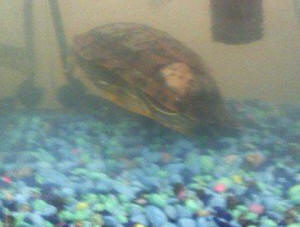 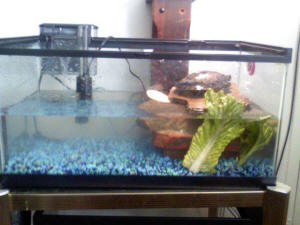 |
|
Rescued Red Eared Sliders 10/6/10
Hello you wonderful people at WWM!
<Hiya gentle reader!! - Darrel here>
I started reading your site since my close friend bought a pair
of Red Eared Sliders. I too fell in love with them (never knew
Sliders had so much personality) and got my own as well about 2
months ago - a pair of 1.5' babies.
<After all these years, still one on my favorites>
Subsequent to that, I adopted a 5 inch slider who was abandoned
at a pet store. Lost one of my small babies to a lung infection
(vets in my country don't deal with herps unfortunately) but
the other one is thriving - she's now about 3' and
growing. They share a tank with ample UV A and UVB lights,
basking area (the big one gets separated out at mealtimes to give
the smaller one a chance at food)
<Sounds like great care>
About 2 weeks ago, I was at a pet store and I saw a little 1'
Slider baby who had white spots all over its shell. After giving
the sales attendant a thorough scolding, I decided to adopt the
1' baby since I was quite convinced it would die if I had
left it there (about a month before, the same pet store had a
rotting dead Red Ear in the tank and didn't bother fishing it
out).
<I sympathize and agree with you about such sad
conditions.>
I also bought several tubes of anti fungal drops, anti bacterial
drops and appetite accelerators - the baby was still quite bright
eyed and active despite the shell condition.
<That's great to hear!! I can't say I have faith in
anti-fungal, bacterial or appetite drops from such stores -
usually those products are ineffective>
After reading several advice already given, I dry docked the
little one for a few days, administered the anti fungal and anti
bacterial drops in turn. The back shell near the tail was very
very soft (would bend if I applied slight pressure).
<Soft shell is a lack of calcium, vitamin D and sunshine (UV)
in most cases treatable by correcting those deficiencies>
After a week, most of the smaller white spots cleared up, but
there was a large persistent one on the left side of the shell
just above the leg. I didn't touch the white spots very much,
in case it was painful for the little one. All this while, the
little one had a decent
appetite and was pooping regularly (oh the joy of watching them
poop! My friend thinks I'm weird, but when they poop, it
reassures me that they're okay!)
<You're correct. APE in the acronym
(Active/Pooping/Eating) that indicates a positive situation: Lack
of any one of the three is the second sign of problems (the first
sign is any change from an established routine that can't be
explained)>
Yesterday, I examined the little one's shell and noticed that
bits of it were peeling away, like fish scales, particularly
where the white spots were concentrated. I lifted the peeling
bits as far as it went and trimmed off the peeled parts. But when
I got the big white part, the whole thing came off! The white
bits were quite dry and compact and came of in chunks and the
area around the white bits looked normal and healthy. So the
little one now has a gaping space where the white spot used to
be.
<The normal shedding of scutes is done in thin
almost-transparent layers that could look like fish scales
'¦ but if the shedding is of the underlying material
(not transparent or translucent) then it's a medical
problem>
Just wanted to check whether the danger is over? And based on
your experience, will the little one always have a gaping space
on its shell or will it grow back over the years (if it
survives!)
<From the pictures I looks like that piece of the shell was
weakened from lack of vitamins and sunshine to the point where it
eroded through. As the turtle grows that shell erosion will look
smaller and smaller until it would never be noticed by anyone who
didn't know to look for it>
Have put in some pictures (one when I first got it, and 2 after
yesterday's shocking post-white-stuff-came-off experience).
Apologies for the blurriness - don't know if you can see
anything but that's the best I can do with my dodgy phone
camera (don't have any other cameras)
Thanks a lot you guys!
Yazmin
p/s - I've refrained from naming the little one until I know
he's got a fighting chance of surviving!
<If he's active, pooping and eating, he has a fighting
chance! You're doing everything right so far. Don't stop
treating him topically (whatever drops you're using seem to
be working) make sure he gets calcium-rich foods and plenty of
UV-B or better yet, natural sunshine. I'd treat for at least
a month after the last white spots are gone and/or the shell
becomes firm under the touch before I'd place him into an
aquatic environment again>
|
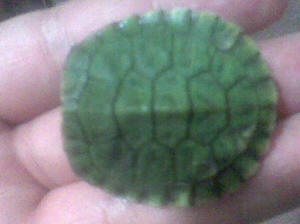 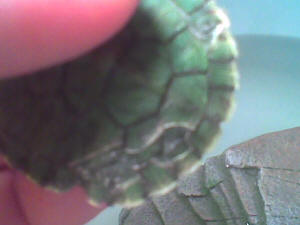 |
Yellow faced turtle - injured? 10/2/10
Hi there!
<Hey there Ho there!! Darrel here there!>
Thanks for taking the time to read this :)
<No problem Shinji - it's why I get the big bucks>
I purchased two yellow faced turtles about 1.5months ago, from a
coworker. They are a turtle local to the Northern Territory of
Australia, and they are aquatic. They originally came in a tank about
250L, but we made a raised pond for them which is 300L of water with a
lip around the edge for them to sun bake and exercise on.
<Sounds good so far>
They are about 10-15cm long, brother and sister. I feed them every
second day with frozen food (which I defrost first). I also treat them
with things like lettuce, and prawns and fresh fish as we get it. We
planted around the tank with lettuce and parsley for them to eat as
they wish, and they love eating one of the floating pad plants we have
in the pond. Oh! And I'm an avid fish keeper, so I have two filters
in the pond, and do water changes weekly.
<Sounds very good. I would do a bit more research on their diet in
the wild. If you're describing genus Elseya you can reduce the fish
& prawns as they grow and gradually replace that with regular Koi
food pellets. It's less expensive and actually better for
them>
Lately I've noticed the boy developing splotches. These splotches
are the colour of rust, and started near his mouth, but I have now
found them on his tail and underside of his shell. One or two are small
on his legs and very slightly raised. Maybe a scab, but too small to
tell. None are bigger than a 5c piece.
<I think a 5 cent piece is far big enough to examine.>
His shell is hard, and clean, eyes are clear. He's VERY active and
feisty and will claw my hands up when he doesn't want to be held
anymore, and looks around attentively. The girl is much shyer and will
hide whenever anyone goes close. I haven't been able to catch and
inspect her. She's way too fast a swimmer, but on the weekend she
had small marks at the corner of her mouth as well.
<OK>
I'm not sure what it is caused by. I have Googled and read tons of
stuff, and the only thing I have come up with is they might be mild
scrapes from something in the tank. But I don't think they've
eaten anything that would hurt their mouth? It's ridiculously hard
to find information on these turtles so I don't have much to go
on.
<I agree>
Do you have any idea what could be causing this?
If you have no clue from the description, I can take pictures in a
couple days.
<If you take pictures, make sure that you have focus - often people
try to get too much of a close-up and all we see are blurry
colors>
Thank you for any help you can provide! Our whole family loves them and
we don't want anything bad to happen!
Shinji
<Shinji - what you describe is odd. It's hard to get a visual in
the mind of what you're actually seeing, so let's run down a
general list.>
<First, can you rub the brownish spot with a Q-Tip or cotton swab
and get any of it to rub off? If not, what about a swab dipped in
alcohol or even vinegar? Does anything loosen the material? If it any
of it rubs off, does it have an odor? (If you use vinegar, don't
bother with the smell test). You can use the eraser on a #2 pencil as
well. Try a very small area. I know this sounds mean, but if we
can't tell what it IS we can often guess what it is by seeing
what's UNDER it. If you rub a piece of and there is raw skin
underneath (like a wound) then it may be a scab.>
<If you wet the area with hydrogen peroxide and the "scab"
turns white, it's possible that it is a mold growing on the skin
and putting root-like material down in the tissue. The more we find out
how it reacts, the more we can focus on what it might be>
<In the mean time, take them out of the water and keep them warm and
dry for 3 or 4 days. I'm giving you a link on treating common
illnesses, but that link has a section on what we call "Isolation
treatment" which is how to keep them warm and dry for long periods
-- almost every condition causing these spots in encouraged in warm,
moist aquatic conditions and DISCOURAGED in warm DRY conditions. Try it
for a few weeks and see how the situation changes. Also, and I
can't stress this enough, unfiltered natural sunlight!!! Direct
sunlight is immensely beneficial to treating almost all skin
conditions. Make sure, of course, that they have shade to be able to
get out of the sun - and remember, sunlight through glass loses
it's benefit.>
<Do some of these tests and write back with results>
<
http://www.wetwebmedia.com/FWSubWebIndex/treating%20RES%20Dis%20DarrelB.htm>
Turtle 9/23/10
Dear Crew
<Hiya - Darrel here>
My turtle had a small white spot on the top of his shell and it was
soft, and I thought it might be shell rot so I was
drying him off and trying to scrape it carefully a little each day.
<OK>
Well if came off and I thought he was ok, but I've been looking at
it and it was still soft. so I was scraping it (not hard) again today
after he had been in a dry box for several hours and a soft chunk came
out of his shell. its kind of brownish and has like 2 small holes in
it. inside his shell underneath the hole I can't tell if its still
kind of brown or pinkish, and its still soft in there too. did I hurt
him taking that chunk out??
<IT sounds like a part of his scute came off a bit earlier than it
should have, displaying the pink "uncured" new scute
underneath.>
<Overall, with very little data to go on, I'd suggest you keep
him warm & dry for a while, just putting him in a shallow bowl of
water each day to drink, eat & poop -- while you let the shell
heal.>
it came out so easily and he wasn't squirming or anything. I
don't know whets wrong with him.
<Next, I'd suggest that you read the enclosed article
<<?>> and check out your care -- I suspect lack of calcium
(correct the diet) and/or UV-B light is at the heart of the
problem>
<That said, check all your care against the standard and correct
anything that is lacking>
red-eared slider care 9/12/10
Hi,
<Hiya - Darrel here>
I have 3 adult red-eared sliders in an outdoor pond. My pond is 1,600
gallons. We live in Chicago so our turtles live in the outdoor pond
from late spring to early fall. Overall they are very healthy, very
active, eat well (water lettuce when they are in the outdoor pond and
food pellets when we bring them inside), they have a basking area,
plenty of hiding spots in the water and a beach area for laying/burying
their eggs.
<That sounds great. I wish someone would provide all that for
ME!!>
The females bask more than the male but I feel they get a decent amount
of basking time considering our crazy weather. Anyway, we keep a
comfortable level of salt in the water for the general health of the
frogs, Koi, goldfish and turtles. I give the turtles occasional warm
salt baths, dry dock them and apply their shell ointment. Getting to my
point, this summer I have noticed their shells appear dirtier, or like
they have some algae on them. In researching shell rot, I really do not
think that is what they have, there are no soft spots, etc. on their
shells. I would think that the reasoning behind this could just be not
enough basking time?
<Sort of - yes. But read on>
But, I can't make them bask and would hate to have to start some
crazy ritual of dry docking them under a UV lamp and would also hate to
keep them in their indoor pond year round. We love having them outside
and they seem very happy.
<Age and size combine to make their shells a bit more porous as they
age. The pits provide a perfect foothold for algae. If the turtles
don't bask sufficiently to kill that algae, it grows a bit
more.>
<In the wild, in the swaps of Florida, I've caught adult River
Cooters (a close relative of the slider) with so much algae that they
looked like a green furry helmet with legs -- and those turtles were in
every way we could measure, perfectly healthy.>
I did read about sulfa dips and was thinking maybe I should be doing
that as just a preventative measure but ideally I would rather just put
a sulfa block in the water. The sulfa blocks they sell at the pet
stores are for 20 gallons of water. If you feel that a sulfa block
would be a good solution, do you know of anywhere to get really large
sulfa blocks? I cannot seem to find much help/information on the sulfa
block topic.
<They're only a solution for the guy who makes them so he can
send his kids to a better school - they are of NO value to turtles,
frogs, Koi, etc. None.>
Otherwise, would you recommend that I take a toothbrush and lightly
clean their shells?
<That's exactly what I do. Take a tooth brush dipped in hydrogen
peroxide and give the shell a gentle scrubbing. Rinse in fresh water
and let them air dry for an hour. This may be a perfect thing to your
yearly preparations for winter. Clear off the summer's accumulation
of algae before coming indoors>
<There was a wonderful quote once that said something like "at
the end of a well spent summer day you should smell like dirt."
Maybe for a turtle its "At the end of a healthy summer, you should
come home with a bit of algae growing on your back">
Is there some other illness that I am not aware of that would result in
shells looking as I described?
<Nope>
I am afraid to just ignore it and have it lead to shell rot or
something worse-any help would be so greatly appreciated
<I clean it off more for aesthetic reasons than anything else.
I've neither experienced nor read about any negative consequences.
In my mind, I THINK that it can't be good'¦ something
growing on their back, pushing roots in between their scutes, etc. so
it just seems like the "right" thing to do.>
-your website is a wonderful resource and I thank you for all your
useful information
<Yer welcome>
-I have referenced it on many occasions!
<That's what we're here for>
<And something in return -- the turtles appear to be getting
excellent care, so congrats to you as well!>
Re: The Story Of The Bad Owner Who Wishes To Repent For His
Actions. Sys., hlth. 9/12/10
Wow, thanks for the quick reply Darrel.
<No charge!>
I wasn't expecting it. But not in an offensive way, as in I thought
you guys might get so many questions that you'd have to pick and
choose which to reply to. Also, thank you for not hating me.
<We do get a lot of questions and sometimes we answer the ones most
critical. For me, I spend more time on spelling, punctuation and
misplaced participles than anything else>
<DUE KNOT Re: LIE TWO MUCH ON SPELL CZECH!>
I've read the suggested articles and your reply and I have a few
more questions.
<Fire away>
My turtle might have a fungus? How might I know? Should I take her to a
vet?
<Not necessarily. Fungus is easy and inexpensive to treat>
I saw bricks in one of the exemplified setups.
<In shallow water, they're fine. I'm trying to show people
that it doesn't take a lot of money to make them a livable and
healthy home.>
Currently, the floating raft she has isn't connected to any source
of stability as I mentioned before. Also, it's upside down because
if I turn it right side up, she turns it upside down again.
<Yes - and because of this, I'll bet she can't climb
COMPLETELY out of the water and therefore can't get COMPLETELY dry.
Finding a way to fix that problem, so that she can get totally out
& dry is an important step here.>
She has a difficult personality. Because of this, she is never
completely out of the water. Her limbs and underside are always in
contact with water. Would removing that and stacking some bricks be a
better setup?
<Yes. She does need to be able to get completely dry. If the water
is very deep, then it takes too many bricks to make that practical.
Sometimes people just take a piece of wood - a flat piece like a shelf
or a round piece like a small tree branch - and stick it in with one
end down on the bottom and another leaning up against the sides. There
are many different ways to can approach this>
You mentioned getting a basking lamp. I have a UV lamp that came with
and fits completely over the tank, is that not good for basking?
<Well, if it's a typical aquarium, it's probably a Plant-Gro
bulb or something like that and they're usually not sufficient UV-B
output for reptiles. Also, a florescent lamp (long tube-type lamp)
generates no heat, so it doesn't help for basking needs>
I didn't know it had to be two different lights. Also, There is a
sheet of glass under the lamp, but it's the only thing holding it
up. Is that a problem? You said it "defeats the purpose of the
bulb" but I didn't completely understand that, sorry.
<No - that's a good topic to discuss. Our readers will
appreciate it, so here goes>
<Ultraviolet light waves are small and have a very low intensity. A
way to think of it is that they don't have a lot of
"energy" and so they wear out easily. UV from a man made UV
bulb is so weak that it can't go very far (8 to 12 inches from the
bulb) before it's no good and it can't penetrate objects like
glass. Even screen, like the screen on our windows to keep out insects,
causes so much of the UV light waves to hit the screen fabric and just
stop there, that screen can reduce the effectiveness of UV light by
more than half.>
<So - to be effective, the UV has to shine directly on the basking
area from a distance of no more than 12 inches>
<The basking lamp is to generate heat - to help her shell dry off
completely, which helps control fungus and parasites & such>
I've turned down the heater to around 78 degrees and will keep
turning it down as you suggested.
<Good>
What temperature should I let it get before I take the heater out?
<Leave it about 75 degrees until you solve the basking problem - we
want her to have a place where she can get warm and dry - and that
she's actually used to being on>
I'm also curious as to how the isolation treatment can be like a
vacation? Sorry to make you explain, just curious.
<No problem. Turtles live in an aquatic environment but it's
also an environment that hosts fungus and bacteria and parasites. While
a turtle lives well in the water, so do all the things that want to
attack her and cause her problems. As long as she's well fed,
basking, plenty of UV, etc. the bad things have no chances with her.
But anytime that's not the case -- any time a turtle has been
injured, has a dietary problem, may not have been basking, etc.
it's good to get them away from the things that may be attacking
them>
<In your case, even though we don't know anything specifically
"wrong" with her, only that we want to give her a chance to
be her best '¦ keeping her warm and dry for a week or two (a
short bath every evening to drink, poop and eat) gives her time AWAY
from all the things that could be trying to hurt her.>
You said "NO plant bulbs." Are they bad? Because I did put
some in there. She ate the onion and two water lily bulbs. Is that a
problem?
<No - I meant Plant-GRO bulbs. Because they aren't the right
wave length to do her any good. Lily and Hyacinth bulbs are fine for
her>
There are such things as turtle/tortoise clubs?
<Yes there are. And the advantage is that you can find someone who
has learned over the years that could give you some hands-on
help.>
I wouldn't have thought of that.
<They're very useful, especially if you ever suspect a disease.
In the event of a disease, someone who can put his hands on the turtle
who's experienced many cases before can save a lot of time and
expense.>
If I may say, you are very funny and I loved the joke electing the
nonfunctional brain to congress in the article about common
diseases.
<A lot of people say I'm "funny" but I'm not
always convinced they mean 'ha-ha' funny>
<I was hoping I knew an experienced turtle person in your city, but
as it turns out, I don't.>
<The most important thing I'd like for her right now is warmth
and UV light. I hope you're taking advantage of this season to get
her outside, at least for daily walks if not something a bit longer.
Nothing is as good as natural sunlight, but considerations have to be
made: Any pen or container she's put into outside must have an area
with shade so she can get out of the sun when she's too warm,
covered with some sort of protection from dogs, raccoons and even
hawks, etc. It seems simple but it gets complicated in a hurry. Still -
it's summer and there's sunlight and she needs it, so I hope
you can give her some>
<For the longer term, there are bulbs you can buy that will fit into
the existing florescent fixture that will provide the UV she needs.
Also, a basking lamp can be just a simple 60w ordinary incandescent
bulb hung over the basking area.>
<Hope that helps!>
|
Turtle shell going upwards
8/31/10
Hi
<Hiya Darrel here!>
We bought our son a Red Eared Slider about a month ago.
<OK>
When we brought it home we set it up in a tank gave it proper
lighting and started to feed it twice a day 3 pellets. We just
started to notice that the shell is going upwards and its at the
end where its happening. We are very concerned
<Nothing to worry about. He's eating slightly too much and
his shell is growing a little faster as a result>
--- although its attitude has not changed
<Good '¦ because a Red Eared Slider with an
attitude problem is not a happy thing: I have a grown adult
female that STILL blames me for the Jimmy Carter
presidency!!>
--- he's still does everything he use to do before. We would
really appreciate your help!
<Maria -- I'd do two things. First, cut his feedings to
"all the pellets he can eat in 5 minutes, twice a
week." Second, just to be sure, compare your setup and care
against the basics given here:
http://www.wetwebmedia.com/FWSubWebIndex/RESCareBarton.htm
>
|
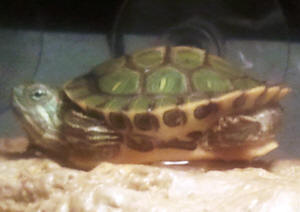 |
|
Unusual shedding 8/26/10
Dear Crew,
<Hiya - Darrel here>
I have two Red Eared Sliders, Donatello and Raphael (yeah, I
know, not the most original names for turtles, but I love
them).
<I like those names. My very first was named Shellby>
I think they're about a year old. I feed them a mixed diet of
turtle pellets, fish, shrimp, and I always try to have aquatic
plants in their tank.
<Fish & shrimp aren't part of their natural diet. If
it was me, I'd discontinue them in favor of the pellets (I
use Koi Pellets) and an occasional earthworm>
I have two places where they can get out of the water and bask.
Their basking area is about 30C. I've had them for a year and
they are still very shy around me. Every time I walk in the room
they dive for cover. They like hiding in their cave. They do come
out when I feed them as long as I don't make any sudden
movements.
<Caves are problematic. Make sure, Sure, SURE, *S*U*R*E* that
the cave is now and will always be big enough that they can never
become trapped>
It's Donatello, the more dominant of the two, I'm worried
about. I've been doing lots of research on-line and reading
your site about growing turtles shedding. I didn't even know
it was possible.
<The shell sections, called scutes, shed in thin, almost clear
sections that look like thin fingernails>
But it seems like they shed their top shell, Donatello is
shedding his underbelly.
<The bottom shell, called the plastron, usually sheds in
almost microscopic pieces, so you normally see nothing>
He is 8cm long. (Sorry for the metric measurements I'm
Canadian.)
<So was my Mom! We eventually cured her of that, however, but
I spent summers with my grandparents outside of St Catherines,
Ont.>
At first the shedding was slow and seemed just like what you were
describing. There was just a thin, nearly transparent little
piece. But recently he has lost larger chunks and not as
transparent. I don't really want to go poking his belly so I
don't know how soft it is. His top shell is nice and hard and
looks good.
<YIKES!!!!>
<That's very unusual. What I see from here looks like a
congenital defect. When turtles are in the egg, the grow folded
in half, so to speak, with their plastron (underbelly) folded up
-- and when they first pop out you can often see a ridge along
the "belt-line." In this picture I "ALMOST"
see that ridge on the right (least damaged) side.>
<That said, I could be totally wrong. You're going to have
to probe it gently and see how firm it is. If it's firm like
"normal" shell material and it doesn't grow in size
and/or depth, then it's a congenital thing that will only
require visual inspection every so often>
<If it's soft or deepens, then a veterinary visit is in
order.>
I haven't noticed a change in his behaviour.>
<^ that's not a typo, folks, that's Canadian for
"Behavior" (they speak in metric)>
He still has lots of energy. Has no problem swimming. Has a good
appetite.
<that's better than me on all 4 counts!!!>
I'm attaching a picture of his underbelly.
<GREAT QUALITY in that photo. How did you accomplish
that?>
Is this normal?
<no>
Am I giving him a good diet?
<You're doing OK, but skip the fish & shrimp. Plants
are great, as are earthworms.>
<Here's a link about basic care -- verify your
temperatures and lighting just to be safe>
<http://www.wetwebmedia.com/FWSubWebIndex/RESCareBarton.htm>
I'm very worried about him.
<Don't fret yet. We have plenty of time for that if things
change>
Carrie, Concerned Canadian living in Japan.
BTW I loved reading the articles on this site. I really like the
relaxed writing style of the site and your responses to
people's questions.
<Thank you, Carrie - we appreciate the feedback!!! It's SO
MUCH NICER than those threats I get from time to time!!>
|
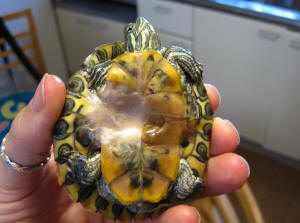 |
|
shells on juveniles -- 8/21/10
Hi, Darryl,
<Hiya>
Thanks, again, for your latest input about my eastern box
turtle.
<Yer welcome>
You asked if he is alert--it seems very alert to me. Doesn't
go running to his food but he notices when I am there. We're
going to the herp vet tomorrow. There are only a couple in town
that I know of and even then, I don't think they are all that
knowledgeable about the various breeds. I, too, love my land
turtles!
<My sulcata eggs JUST hatched.>
I also have a 5 year old tortoise which I rescued from my
backyard in the dead of winter- he was about the size of a
quarter. He is very special to me. Do you know anything about
desert tortoises?
<Yes I do. Send some pictures>
In my first email I had written, I had mentioned I was going to
try to send pictures of my juveniles in which I was concerned
about their shells (carapace). You mentioned that it's
probably water stains. I tried the vinegar treatment but I
don't really notice a difference. Do these pictures help?
Does it look like anything serious?
<They look like simple abrasions to me - like they may be
rubbing on rocks>
They are active and eat well so their behavior seems fine. Let me
know if you think they also need a trip to the vet.
<Nope - make sure the water is clean and that they bask under
UV light and just "watch" to see that they don't
get worse>
I want to thank y'all for this website and support.
<We appreciate the compliment, Denise. --- just for
everyone's information, we have a "donate" button
on the home page '¦ and every dollar helps>
It helps such a great deal knowing there is somewhere certain you
can go to when you are not sure about your pets.
<Thanks again!>
Denise
|
  |
|
|

